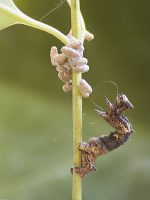 I know it sounds crazy… but it’s actually true!
I know it sounds crazy… but it’s actually true!
The parasitoid wasp Glyptapanteles lays its eggs, about 80 at a time, in young geometrid caterpillars. The eggs hatch and the larvae feed on the caterpillar’s body fluids. When they are fully developed, they eat through the caterpillar’s skin, attach themselves to a nearby branch or leaf and wrap themselves up in a cocoon.
Having partially developed inside caterpillars, the larvae of the wasps manipulate their hosts into watching over them as a mother or bodyguard might.
The caterpillar, still alive, behaves as though controlled by the cocooned larvae. Instead of going about its usual daily business, it stands arched over the cocoons without moving away or feeding.
Here’s a video:
The caterpillar – now effectively a zombie – stays alive until the adult wasps hatch.
“We don’t know exactly what kills the caterpillars, but it is fascinating that the moment of death seems to be tuned to the duration of the wasp’s pupal stage,” says Arne Janssen of the University of Amsterdam.
Although Janssen and his colleagues do not know how the parasites make the caterpillars change their behaviour, they think that a few larvae in each brood may sacrifice themselves to help their brothers and sisters.
“If we dissect the caterpillars, we find one or two parasitoid larvae have stayed behind, even after the rest of the brood has emerged and formed cocoons,” says Janssen.
It could be that the larvae that remain in the host control its behaviour in order to make it protect the rest of the brood.
Cool huh? I found this at New Scientist, where you can read the entire article.
Mark B: I Found My Man!
Mark B: I Found My Man!
Mark Beckert: Worst Sympathy Letter Ever Written
Mark: Definitely Worth A Look Around!!
Mark: Are You A Pagan?





Leave a Reply